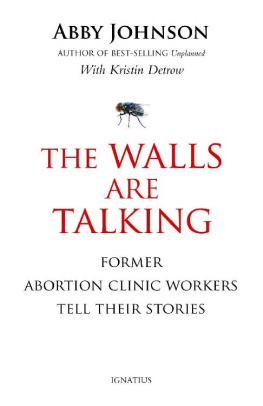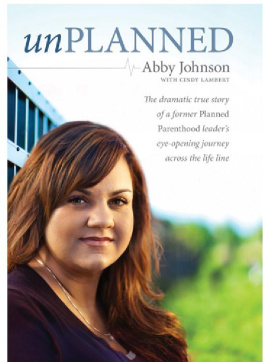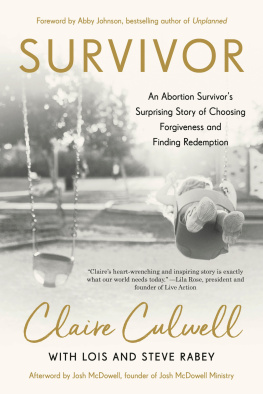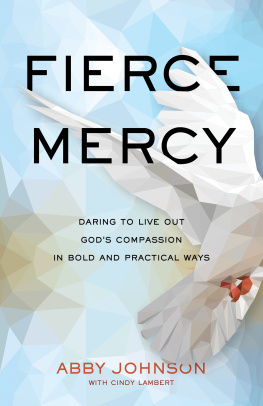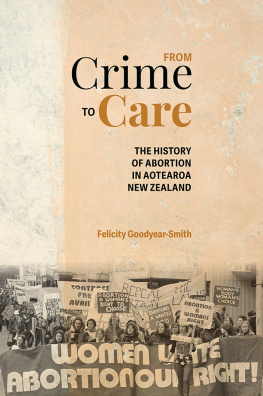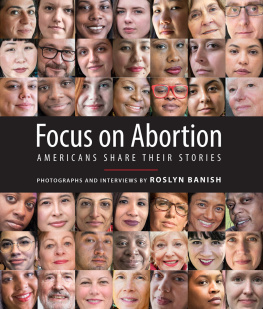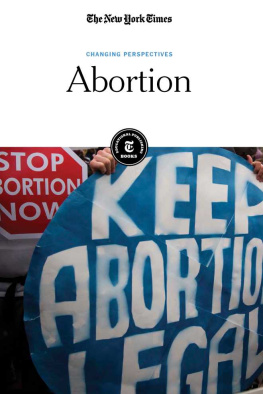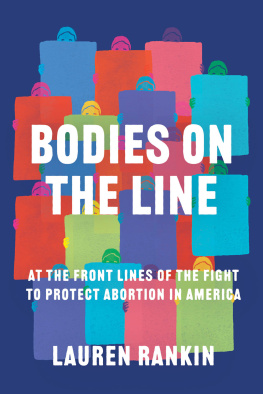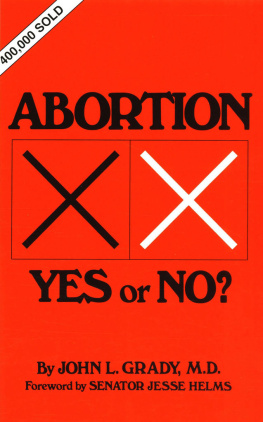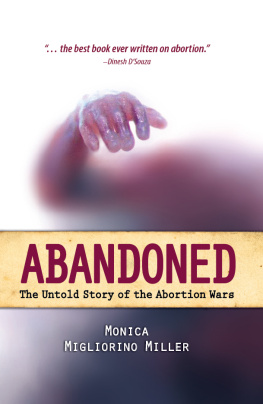THE WALLS ARE TALKING
ABBY JOHNSON
With Kristin Detrow
THE WALLS
ARE
TALKING
Former
Abortion Clinic Workers
Tell Their Stories
IGNATIUS PRESS SAN FRANCISCO
Cover art Shutterstock
Cover design by Roxanne Mei Lum
2016 by Ignatius Press, San Francisco
All rights reserved
ISBN 978-1-58617-797-3 (HB)
ISBN 978-1-62164-250-3 (PB)
ISBN 978-1-68149-699-3 (EB)
Library of Congress Control Number 2014959913
Printed in the United States of America
This book is dedicated to the men and women who have allowed me to be a part of their journey out of the abortion industry. Your courage inspires me every day. You are the definition of bravery. You will never know how honored I am to be a small part of your lives.
CONTENTS
PREFACE
This will not be an enjoyable read. It is a necessary one, however, as it narrates the real-life experiences of former abortion clinic workers who agreed to be interviewed for this book, as well as some of my own. To protect their privacy and mine, I have written all the stories in the first person so that you, the reader, will not be able to distinguish one voice from another. As you read these harrowing accounts, please keep the real people who had these experiences in your prayers. These courageous individuals, who have left their jobs in the abortion industry, have come forward with their stories, not for fame or notoriety, but to make a difference. They want their stories to change the lives of others for the better. They want their past mess to become a message.
ABBYS INTRODUCTION
If These Walls Could Talk
Theres one question only a woman can answer, declares the tagline of HBOs If These Walls Could Talk . The cover boasts a stunning trio of veteran actresses along with Siskel and Eberts highly coveted Two thumbs up!
Of course, moviegoers would expect nothing less from a film starring the likes of Demi Moore, Sissy Spacek, and Cher. The 1996 film amazed the network by becoming HBOs highest-rated made-for-TV movie to date. Much more than mere entertainment, If These Walls Could Talk provoked the minds of Generation Xers to ponder the highly divisive issue of abortion.
If These Walls Could Talk proudly bills itself as a powerful, intimate portrait of how times and freedoms have changed. It will shock you. It will surprise you. And no matter where you stand on the issue, it will force you to think again.
Although critics and fans wholeheartedly agree that the film is powerful and does indeed paint an intimate portrait, the brushstrokes finished work is nothing less than propaganda at its finest.
Using three vignettes spaced twenty-two years apart and set in the backdrop of the same house, If These Walls Could Talk chronicles three women who are faced with unintentional pregnancy and how access to abortion was restricted or hindered by legal constraints and societal views in each decade.
Claire (Demi Moore) is a grief-stricken young widow living in a Chicago suburb in 1952. She becomes pregnant after a drunken tryst with her brother-in-law. Anxious to avoid humiliation and further heartache for her dead husbands family, Claire desperately seeks an illegal abortion. Along the way she is met with cold-hearted judgment and skittish sympathizers. Claires procedure is finally performed by a sketchy travelling abortionist on her kitchen table. The illegal abortion causes her to hemorrhage and ultimately to die.
The second segment features Barbara (Sissy Spacek), a frazzled policemans wife and mother of four. Barbaras hopes and dreams have been placed on the back burner for years, and she is practically a slave to her husband and children. Finally taking the time to focus on herself, Barbara returns to college and seems to have her feet set firmly on the path to fulfillment until an accidental pregnancy tosses a monkey wrench into her plans. Although encouraged by both a post-abortive friend and self-actualized daughter to exercise her recently legalized right to choose abortion, in the end she isnt strong enough to make the decision. Ever a martyr to her family, Barbara sullenly continues the pregnancy.
Fast-forward to 1996. The house is now occupied by Christine (Anne Heche), a promising college student who finds herself impregnated by her married professor. Christines decision to abort is not made flippantly. She rejects the idea on her first visit to the clinic. Despite the pleas of her Jesus-loving best friend and the drone-like protestors at the clinic, Christine returns intent on going through with the abortion. The procedure goes smoothly until a pro-life terrorist bursts through the door, mortally shooting the heroic abortionist (Cher).
The delicate subtlety this movie employs is both genius and insidiously effective. Young viewers who havent been taught to think critically or spent much time considering the complex issue of abortion scarcely stand a chance against the highly sympathetic characters portrayed in If These Walls Could Talk . The unwanted pregnancies seem impossible and abortion the only sensible answer.
Unwittingly, the audience finds itself hopeful that some brave doctor will perform an illegal procedure, rescuing Claire from her risky self-abortion attempts; silently urging Barbara, finally choosing to invest in herself, to terminate her pregnancy; disgusted by the tactless and judgmental pro-life crazies; and horror-struck when one of them violently takes the life of the self-sacrificing abortionist.
Aldous Huxley said, The propagandists purpose is to make one set of people forget that the other set of people are human. If These Walls Could Talk undoubtedly succeeds in completely glossing over the fact that for every woman daunted by an unwanted pregnancy, there is another life at stake: an innocent humana life easily marginalized and depicted solely as a burden; a quandary; an affliction from which hapless women can only be rescued by safe and legal abortion.
The abortion clinic I directed in Bryan, Texas, had a room where women sat and waited for their procedures. There was a door that connected this room to the clinics common areas. Staff members were instructed that those doors must remain locked at all times. For me, it was a hassle to stop and rifle through my keys when moving about the clinic.
But really, it bothered me for an entirely different reason. Something about having those women locked in that room just seemed wrong to me. As if they were trapped there. Finally, I confronted my supervisor about it. She responded by insisting that I watch If These Walls Could Talk . Young and gullible, I completely bought into the lies and was sucked in by the masterful propaganda. One viewing was all it took to convince me fully that a locked door was a minor inconvenience we must suffer to ensure the safety of the clinic staff and our patients.
* * * * *
Multiple volumes could be penned expounding on the flawed logic and distortions in the three scenarios presented in If These Walls Could Talk . While it is vital to meet these lies with truth, that is not the goal of this project. Randy Alcorn did a fabulous job of answering difficult questions in his book ProLife Answers to Pro-Choice Questions .
The Bible teaches that our testimony is a powerful tool for defeating evil. Revelation 12:11 says, They have conquered him by the blood of the Lamb and by the word of their testimony. Sharing my own story of being a post-abortive mother and former Planned Parenthood clinic director has become my lifes work.
September 26, 2009, was like any other normal work day at the clinic until I was unexpectedly asked to assist with an ultrasound-guided abortion. I was excited about the prospect. After all, I was Planned Parenthoods 2008 Employee of the Year. My personal ambition was to become Planned Parenthoods chief operating officer, and I was on the fast track to meeting that goal. Having never seen an ultrasound-guided abortion, I relished another opportunity to gain knowledge and understanding.
Next page
